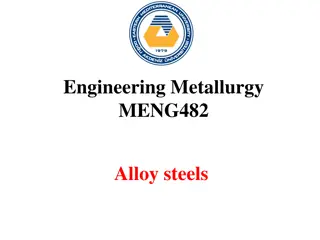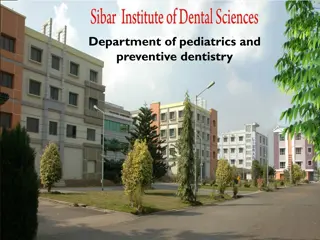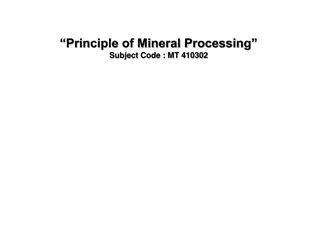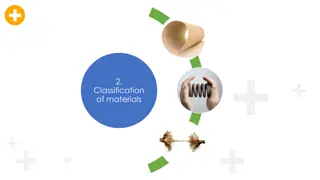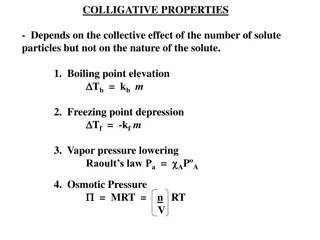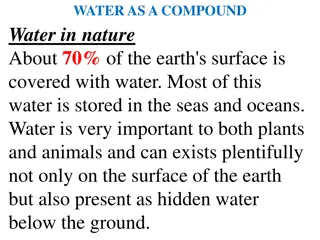Introduction to Material Science & Metallurgy: Understanding Properties and Applications
Explore the fascinating world of material science and metallurgy, diving into the co-relation between material structure and properties. Learn about the historical significance of metallurgy, its branches, and why engineers must study materials for product manufacturing. Delve into the extraction of metals, production of metal alloys, heat treatments, and more.
Download Presentation

Please find below an Image/Link to download the presentation.
The content on the website is provided AS IS for your information and personal use only. It may not be sold, licensed, or shared on other websites without obtaining consent from the author. Download presentation by click this link. If you encounter any issues during the download, it is possible that the publisher has removed the file from their server.
E N D
Presentation Transcript
CH. NO. 1 INTRODUCTION TO MATERIAL SCIENCE & METALLURGY closed cross-sections (tubes, pipes) closed cross-sections (tubes, pipes) pellets pellets open cross-sections (channels) open cross-sections (channels)
LEARNING OBJECTIVES What is material science? What is metallurgy? Why this subject is studied? Brief classification materials. Important properties of each category of engineering materials Classification of engineering materials understanding definition property Criteria for selecting a material for engineering application Process for material selection 1. of engineering 2. properties of 3. and each of 4. 5.
1.1 INTRODUCTION What is material science ? It is the branch of science which explains the co- relation between the internal (chemical or metallurgical) structure of the material with the properties of the material. What is metallurgy ? It is a branch of material science which deals with metals and their alloys. It includes 1. extraction of pure metals from their crude form (ores) 2. production of metal alloys ; and 3. design of processes like Heat Treatment which can improve the properties of metals and their alloys.
1.1 INTRODUCTION Why this subject is studied ? Materials influence all walks of our life. Specifically speaking for engineers, an engineer of any branch has to deal with materials for manufacturing a product. If he is not aware about the properties and applications of different metals and alloys he cannot manufacture a product suitable for a specific task.
1.1 INTRODUCTION History of metallurgy Metallurgy as an art has been practiced since ancient times. Ancient man knew and used many native metals. Gold was used for ornaments, plates and utensils as early as 3500 B.C. The art of smelting, refining, and shaping metals was highly developed by both Egyptians and Chinese. About 1922, more knowledge of the structure and properties of metals was added by the application of X-ray diffraction and wave mechanics.
1.1 INTRODUCTION What are branches of metallurgy ? Metallurgy is classified into following sub-branches Extractive Metallurgy : Extractive metallurgy deals with extraction of metals from their ores (oxides, sulphides, chlorides, etc.) and refining them. Physical Metallurgy : This area of metallurgy is the study of structure property relationship of metals, optimization of properties by manipulating the structure, alloying of metals, heat treatment of metals, etc. Mechanical Metallurgy : Mechanical working of metals, testing of metals for various mechanical properties and causes of their failure are studied under Mechanical Metallurgy. 1. 2. 3.
1.2 CLASSIFICATION OF ENGG. MATERIALS Within the scope of material science, the engineering materials are classified into one of the following four broad groups: Metals & Metallic Alloys Ceramics Organic Polymers Composite Materials 1. 2. 3. 4.
1.2 CLASSIFICATION OF ENGG. MATERIALS Metals & Metallic Alloys Ceramics Organic Polymers Composite Materials Particle Strengthened Refractories Natural Polymers e.g. Rubber, Cotton, Leather, Silk, Wool, Starch, Wood, Cellulose, etc. Synthetic Polymers Ferrous Metals & Alloys Non-Ferrous Metals & Alloys Fibre Re-inforced Structural or Laminar Steels Cast Irons Thermo Plastics e.g. PVC, Polystyrene Thermo-setting Plastics e.g. Epoxides, Phenolic Resins, Bakelite
1.2 CLASSIFICATION OF ENGG. MATERIALS 1. Metals & Metallic Alloys Metals are elements substances that readily give up electrons to form metallic bonds and conduct electricity. e.g. Iron, Copper, Aluminium, etc. When two or more pure metals are melted together to form a new material which is metallic in nature but has quite different properties from the original (base) metals, it is called an alloy e.g. Brass, Bronze, Invar, etc.
1.2 CLASSIFICATION OF ENGG. MATERIALS 1. Metals & Metallic Alloys Before 1800 there were 12 metals in common use Gold, Silver, Copper, Lead, Mercury, Iron, Tin, Platinum, Antimony, Bismuth, Zinc, Arsenic Metals discovered in 18th century 1735 Cobalt, 1751 Nickel, 1774 Manganese, 1781 Molybdenum, 1782 Tellurium, 1783 Tungsten, 1789 Uranium, 1789 Zirconium, 1791 Titanium, 1794 Yttrium, 1797 Berylium, 1797 Chromium Metals discovered in the 19th century 1801 Niobium, 1802 Tantalum,1803 Iridium, Palladium, Rhodium, 1807 Potassium, Sodium, 1808 Boron, Barium, Calcium, Magnesium, Strontium, 1814 Cerium, 1817 Lithium, Cadmium, Selenium,1823 Silicon, 1827 Aluminum, 1828 Thorium, 1830 Vanadium, 1839 Lanthanum, 1843 Erbium, Terbium,1844 Ruthenium, 1860 Cesium, Rubidium, 1861 Thallium, 1863 Indium, 1875 Gallium, 1878- 1885 Holmium, Thulium, Scandium, Praseodynium, Neodynium, Dysprosium 1886 Germanium, 1898 Polonium, Radium, 1899 Actinium Metals discovered in the 20th Century 1901 Europium, 1907 Lutetium, 1917 Protactinium, 1923 Hafnium,1924 Rhenium, 1937 Technetium,1939 Francium,1945 Promethium, 1940-61Transuranium elements Neptunium, Plutonium, Curium, Americum, Berkelium, Californium, Einsteinium, Fermium, Mendelevium, Nobelium, Lawrencium Samarium, Gadalinium,
1.2 CLASSIFICATION OF ENGG. MATERIALS 1. Metals & Metallic Alloys Important properties of Metals are as follows They are solid at room temperature They have good thermal and electrical conductivity They have relatively high density To some extent they are malleable and ductile Most of metals form alloys They possess metallic lusture on polishing When struck with other metal they produce metallic sound They have ability to be deformed plastically They possess crystalline structure They have ability to donate electrons and form a positive iron
1.2 CLASSIFICATION OF ENGG. MATERIALS 2. Ceramics Ceramics are compounds of metallic or non-metallic elements. They have excellent wear resistance and heat resistance. Common ceramics are rocks, minerals, glass, glass fibre, fire clay, abrasives. Imp. properties of Ceramics are as follows Abrasion resistance Corrosion resistance Resistance to high temperature Creep Resisting property Hardness and brittleness Insulating property Refractory lining In blast furnace Carbide tip tools For lathe
1.2 CLASSIFICATION OF ENGG. MATERIALS 3. Organic Polymers closed cross-sections (tubes, pipes) closed cross-sections (tubes, pipes) pellets pellets open cross-sections (channels) open cross-sections (channels) These materials are Carbon Compounds. They usually consist of Carbon chemically combined with Hydrogen, Oxygen or other non-metallic substances. They are long molecular chains. Their structures are fairly complex and three dimensional. E.g. Plastics, Synthetic Rubbers, etc. Important properties of Organic Polymers are Now-a-days Polymers have become substitute to steels and other metals for various engineering applications. They have good mouldability, corrosion resistance, surface finish, low density and low co-efficient of friction. Microstructure of part of a DNA double Helix biopolymer
1.2 CLASSIFICATION OF ENGG. MATERIALS 4. Composite Materials The previous three categories are common or conventional categories of material but as of today there is trend of Advanced Materials which are also known as Composite Materials or Smart Materials E.g. Semiconductors, Bio-Compatible Materials, LEDs, data storage devices, integrated circuits, Carbon fibre for automobile parts, etc. Important properties of Composite Materials are Combination of best properties of constituent materials e.g. fibreglass = fibre + glass : fibre acquires strength from glass and flexibilty from polymer Composite materials have an unlimited potential for higher strength, stiffness and corrosion resistance as compared to metals, ceramics and polymers.
1.3 PROPERTIES OF MATERIALS Definition of Material Property : Material Property is a qualitative or quantitative measure of response of material to externally imposed conditions (force, temperature, etc.) There are hundreds of properties of materials that are measured in laboratories for the purpose of comparing materials. Some of these can be grouped as under Physical : Dimensions, Density, Porosity, etc. Chemical : Chemical Composition, Corrosion resistance, etc. Mechanical : Elasticity, Plasticity, Strength, Ductility, Malleability, Brittleness, Hardness, Toughness, Resilience, Fatigue Strength, etc.
1.3 PROPERTIES OF MATERIALS Electrical electric strength, semi-conductivity, super- conductivity, etc. Thermal : Heat capacity, specific heat, thermal conductivity, thermal expansion, melting point, etc. Magnetic : Permeability, Coercive Force, Magnetic Hysteresis, etc. Optical : Refractive Index, Absorptivity, Reflectivity, etc. Technological : Castability, machinability, weldability, solderability, formability, etc. : Resistivity, Conductivity, Di- workability,
1.3 PROPERTIES OF MATERIALS (1) Physical Properties (i) Dimensions : This includes size, shape and tolerances on the materials. Size of a product is determined by breadth, width, length, diameter, etc. Shape of a product is determined by looking at the cross section like rectangular, circular, I- Shape, channel, angle, etc. Tolerances are determined based on accuracy of size and shape required as per application of the product.
1.3 PROPERTIES OF MATERIALS (1) Physical Properties (ii) Density : Weight per unit volume of a material is known as its density. For metals it can be calculated as under Density = . Mass . Volume Application of low density metals and alloys of Aluminium and Magnesium is well known for transportation and aerospace industry.
1.3 PROPERTIES OF MATERIALS (1) Physical Properties (iii) Porosity : Material containing pores within it is said to be porous material. It can be calculated as under Porosity = . Total Pore Volume . Bulk (Total) Volume Porosity is an important parameter for testing sintered products which will be discussed at the chapter powder metallurgy.
1.3 PROPERTIES OF MATERIALS (2) Chemical Properties (i) Chemical Composition : Composition of a material can be determined by analytical chemistry. In metals and alloys the percentage of various elements which make up metals and alloys decide the composition. For example, cartridge brass has 70% copper and 30% zinc. Therefore, composition of this brass is 70-30.
1.3 PROPERTIES OF MATERIALS (2) Chemical Properties (ii) Corrosion Resistance : Corrosion is deterioration of a material by chemical reaction with its environment. Corrosion affects both the metallic as well as non- metallic materials like bricks, concrete, etc. For example, rusting of iron occurs in humid atmosphere, corrosion of concrete occurs by sulphates in solids. Material properties are de-graded by corrosion and its economic values are reduced. An engineer must understand the mechanism of corrosion and methods to avoid it.
1.3 PROPERTIES OF MATERIALS (3) Mechanical Properties (i) Elasticity : Each body will more or less deform on application of load. The deformation will be elastic when the body recovers its original shape completely after removal of load. Ability of a material to re-gain its original shape and size after removal of load is known as elasticity. For each elastic body, a certain limit exists, beyond which the material will hold a remaining deformation. This limit is called elastic limit. Young s modulus of elasticity : E = Strain Examples of elastic material Steel, Rubber, etc. Steel is said to be more elastic than rubber. Stress .
1.3 PROPERTIES OF MATERIALS (3) Mechanical Properties (ii) Plasticity : The ability of a material to be permanently deformed without fracture, even after the removal of load is known as plasticity. Plastic deformation will take place only after the elastic limit has been exceeded. It is of importance in forming, shaping and extruding operations. Some materials are shaped cold e.g. the deep drawing of the sheets. Many materials particularly metals are shaped hot e.g. the rolling of the structural steel shapes and the forging of certain machine parts. Material like clay, lead, etc. are plastic at room temperature, and steel is plastic when at high temp.
1.3 PROPERTIES OF MATERIALS (3) Mechanical Properties (iii) Strength : Ability of a material to withstand stress without fracture is called its strength. It is expressed as force per unit area of cross section. The material has to withstand different types of forces such as tensile, compressive and shear. Hence strength is also known as tensile, compressive and shear strength. The strength of a material plays a vital role in designing component of a machine or a member of a structure.
1.3 PROPERTIES OF MATERIALS (3) Mechanical Properties (iii) Strength : Tensile Testing Measures a materials tensile strength Clamps for Holding Specimen Dial Gauge to Measure Extension of Specimen
1.3 PROPERTIES OF MATERIALS (3) Mechanical Properties (v) Ductility : The property of a material to undergo deformation under tension without fracture is called ductility. It enables material to be drawn out or elongated to an appreciable extent before rupture occurs. Ductility of a material can be measured by the % elongation and % reduction of area before rupture of a test piece. (vi) Malleability : The capacity of a material to withstand deformation under compression without malleability. Forging and rolling operations in which metal is formed by hammering or rolling utilize malleability. rupture is called
1.3 PROPERTIES OF MATERIALS (3) Mechanical Properties (vii) Brittleness : The property of a material by virtue of which it will fracture without appreciable deformation is called its brittleness. Brittleness is opposite to ductility. Therefore a non- ductile material is said to be brittle. (viii) Hardness : Ability of a material to withstand scratching, wear, abrasion, indentation or penetration by a body made of some other material is known as hardness. Hardness is an important property of cutting tools and components which are subjected to wear and tear during use. It can be measured using Brinell Hardness Test Machine, Vicker Hardness Test Machine, etc.
1.3 PROPERTIES OF MATERIALS (3) Mechanical Properties (viii) Hardness : Hardness Testing Measures the materials resistance to indentation or scratching Hardness Value Read Directly From Dial Table Height Adjustment Indenter Test Component will be placed here (on table) Activating lever Direct Reading Hardness Testing Machine (Vickers or Brinell)
1.3 PROPERTIES OF MATERIALS (3) Mechanical Properties (ix) Toughness : Toughness is the ability of a material to absorb energy and plastically deform without fracturing OR Toughness is the amount of energy that a material can absorb (per unit volume) before it fractures. It is also defined as the resistance to fracture of a material when stressed. Toughness requires a balance of strength and ductility Area under stress-strain curve represents toughness of that material. A ductile material with same strength as non-ductile material will require more energy for breaking and hence it is more tough. For example, when a load is suddenly applied to two pieces, one of mild steel and other of glass, the mild steel will absorb more energy before it fails. Hence mild steel is tougher than glass. Charpy or Izod Impact tests are used to measure the toughness of material. Its unit is kgf-m or Joules.
1.3 PROPERTIES OF MATERIALS (3) Mechanical Properties (ix) Toughness : Izod Impact Test Measures a materials toughness Scale to read energy absorbed in breaking the specimen Start Position of Pendulum Test Specimen Held Vertically Pendulum Vice
1.3 PROPERTIES OF MATERIALS (3) Mechanical Properties (x) Resilience : Resilience is the property of a material to absorb energy when it is deformed elastically and then, upon unloading to have this energy recovered. In other words, it is the maximum energy per unit volume that can be elastically stored in a material upon application of impact force. It is represented by the area (integral) under the curve in the elastic region (the initial, linear portion) of the stress-strain curve. This quantity is also known as the elastic potential energy of a material.
1.3 PROPERTIES OF MATERIALS (3) Mechanical Properties Difference between Resilience & Toughness This area represents Toughness This area represents Resilience Stress Strain Curve of a ductile material
1.3 PROPERTIES OF MATERIALS (3) Mechanical Properties (xi) Fatigue : The failure of material caused under repeated loads or stresses is known as fatigue or fatigue failure. Examples : Some examples of components which are subjected to fluctuating loads or alternate stresses are : 1. Connecting rods are pushed and pulled in piston engines 2. Leaf springs bent to and fro. 3. Air craft wings are subjected to turbulent air. 4. Some parts of compressors, pumps and turbines, etc are subjected to repeated loading and vibrations.
1.3 PROPERTIES OF MATERIALS (3) Mechanical Properties (xii) Creep Creep is the slow and progressive deformation of a material with time at constant stress. A material subjected to constant tensile load at an elevated temperature will creep and undergo a time dependent deformation. Most metals creep at high temperature whereas soft metals, plastics, rubbers, etc creep at low temp. Examples 1. Soft metals used at about room temperature such as lead pipes and white metal bearings 2. Steam and chemical plants operating at 450-5000C. 3. Gas turbines working at high temperatures. 4. Rockets, missiles, supersonic jet parts. 5. Nuclear reactor parts.
1.3 PROPERTIES OF MATERIALS (4) Electrical Properties (i) Resistivity : The electric property of a material owing to which it impedes or resists the flow of electricity through it is called electrical resistivity of a material. (ii) Conductivity : The reciprocal of electrical resistivity is called electrical conductivity. (iii) Di-electric Strength : Di-electric materials are those materials which are used to store electrical energy. They are generally used in capacitors and as electrical insulators. Di-electric strength or voltage is the minimum voltage which when applied to a di-electric material will result in the destruction of material.
1.3 PROPERTIES OF MATERIALS (4) Electrical Properties (iv) Semi-conductivity : Conductivity of a material between that of conductors and insulators is known as semi-conductivity. (v) Super-Conductivity : Certain metals and a large number of inter-metallic compounds exhibit zero resistivity when they are cooled below absolute zero temperature (-2730C). This property is referred to as super conductivity. Materials possessing super conductivity are used in medical field for MRI (Magnetic Resonance Imaging) and they are potential tools for future power transmission lines, computers, Bullet Trains, etc.
1.3 PROPERTIES OF MATERIALS (5) Thermal Properties (i) Heat Capacity : A solid material when heated, experiences an increase in temperature signifying that some energy has been absorbed. Heat capacity is a property that is indicative of a material s ability to absorb heat from the surroundings. (ii) Specific Heat : The specific heat of a substance is the amount of heat required to raise temperature of a unit mass of substance by one degree. (iii) Thermal conductivity : Amount of heat conducted per unit time through a unit area perpendicular to the direction of heat conduction when the temperature gradient across the heat conducting element is one unit.
1.3 PROPERTIES OF MATERIALS (5) Thermal Properties (iv) Thermal expansion : When thermal energy is added to a material, a change in its dimension occurs. This phenomenon is called thermal expansion and the property responsible for it is termed as co-efficient of thermal expansion. (v) Melting point : The melting point of a solid is the temperature at which it begins to melt.
1.3 PROPERTIES OF MATERIALS (6) Magnetic Properties (i) Permeability ( ) : Permeability is defined as the ratio of magnetic flux (B) and the magnetic field strength (H). (ii) Coercive Force (HC) : This is the reverse magnetizing force necessary to eliminate the residual magnetism (Br) (iii) Hysteresis : It can be defined as lag in the changes of magnetization behind variations of the magnetic field. If a ferromagnetic material is subjected to increasing or decreasing magnetic field, the changes in the magnetic induction (B) plotted against the magnetic field (H) result in a loop known as hysteresis. It represents the energy loss during that cycle.
1.3 PROPERTIES OF MATERIALS (7) Optical Properties (i) Refractive index : It is the ratio of velocity of light in vacuum to the velocity of light in any other material. It is also expressed as ratio sine of angle of incidence and sine of angle of refraction. (ii) Absorptivity & Reflectivity: The energy incident on any material gets partly absorbed and partly reflected. The decimal fraction absorbed is called absorptivity of material and part reflected is called reflectivity of a material
1.3 PROPERTIES OF MATERIALS (8) Technological Properties (i) Castability : It is the ease with which a material can be given various solid shapes from liquid state. Factors which affect the castability are solidification rate, shrinkage, segregation, gas porosity, etc. (ii) Machinability It is defined as the ease with which a given material can be cut or removed by cutting tools in machining operations , with satisfactory surface finish. Factors affecting machinability composition of work piece material, microstructure, mechanical properties, cutting conditions, etc. are chemical
1.3 PROPERTIES OF MATERIALS (8) Technological Properties (iii) Weldability : It is defined as the capacity of the metal to be welded under the fabrication conditions imposed in a specific suitable designed structure satisfactorily in intended service life. Factors affecting weldability are composition of metal, affinity for oxygen and other gases, etc. (iv) Workability or formability The ability of metal indicating the ease with which it can change it shape while in solid state is called as its workability or formability. Factors affecting workability are ductility of metal which in turn is based on structure, grain size, alloying elements, softening heat treatment given to metal, etc. and to perform
1.4 CRITERIA FOR SELECTION OF MATERIAL FOR ENGG. APPLICATIONS (i) Properties of material (ii) Performance requirements (iii) Processing of materials (iv) Safety (v) Material Reliability (vi) Economic factors (vii)Disposability, Re-cycling and Re-use
1.4 CRITERIA FOR SELECTION OF MATERIAL FOR ENGG. APPLICATIONS (i) Properties of material : When selecting a material a primary concern of engineer is to ensure that the material properties are consistent with the operating conditions of the component. When selecting a material a primary concern of engineer is to ensure that the material properties are consistent with the operating conditions of the component.
1.4 CRITERIA FOR SELECTION OF MATERIAL FOR ENGG. APPLICATIONS (ii) Performance requirement : Before selecting a material, process or design for a part we must thoroughly conditions. For example, for a component part to be used for aerospace application, weight if critical, since additional vehicle weight increases fuel consumption and reduce range. Many advanced aerospace vehicles use composite materials instead of aluminium. These components such as carbon epoxy compounds are more expensive than traditional aluminium alloys however fuel saving yielded by higher strength to weight ratio of composite materials may offset the initial investment. understand service
1.4 CRITERIA FOR SELECTION OF MATERIAL FOR ENGG. APPLICATIONS (iii) Processing of Materials The most important property of a material is it processability. For example, one of the great advantages the metals offer is that, as a result of slip systems in their structure they can be rolled into thin sheets. Primary material processes deformation and powder agglomeration. Secondary material processes are used for assembly and finishing. These include welding, machining, heat treatment, finishing operations. Success of both the Primary and Secondary operations depend on the structure and properties of material. include casting,
1.4 CRITERIA FOR SELECTION OF MATERIAL FOR ENGG. APPLICATIONS (iv) Safety A material must safely perform its function. For example, if a material is selected which is brittle and used at low temperature in pressure vessels, bridges, ships and pipe lines it will be unsafe due to brittle failure. Brittle failure is to be avoided at all costs because it occurs without any prior warning and usually produces disastrous consequences.
1.4 CRITERIA FOR SELECTION OF MATERIAL FOR ENGG. APPLICATIONS (v) Material reliability Reliability can be stated as the degree of probability that a product and the material of which it is made, will remain stable enough to function in service for the intended life of product without failure. For, example if a component part is to be used in corrosive environment, selection of mild steel instead of stainless steel will result in failure and as a non- reliable material.
1.4 CRITERIA FOR SELECTION OF MATERIAL FOR ENGG. APPLICATIONS (vi) Economic Factors : Cost perhaps is more often than any other constraint, is the controlling factor in a given material s application problem. The total original cost of a material for a given application is made of two parts (i) cost of material and (ii) cost of processing the materials into the finished part or product. Cost accounting is an important tool for the engineer, who must achieve the combination of materials and processing for a given component. financially responsible
1.4 CRITERIA FOR SELECTION OF MATERIAL FOR ENGG. APPLICATIONS (vii) Disposability, Re-cycling & Re-use These are increasingly important factors during selection of materials. For example, disposability of nuclear materials is very important. Re-cycling or re-use may not always figure into the life-cycle of an engineering component. We may re-manufacture large pieces of equipment because they are too costly to replace, or we may re- generate scrap that is recycled because doing so is economical.



